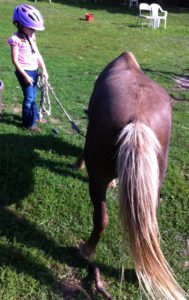Equestrian riding helmets should be the first item on the list of what to wear horseback riding.
Being prepared for an accident is smart, not over-reactive. No matter the age of our rider or the discipline. The safety of our horses is the responsibility of trainers, owners, and riders. They must practice safe horsemanship. It is also the trainers, instructors, and parents’ responsibility to require riders to wear approved safety equipment.
Let’s talk about why every person should wear an Equestrian Helmet while working with horses.
I always required helmets to be worn if a horse was not in a stall or a pasture. My students wore their helmets while grooming their horses or leading their horse/pony. Because any horse can get scared and break away from the person holding them and run into someone else, and any horse can pop you in the head when getting its hoof picked out or getting its legs groomed. I have learned that many instructors don’t require wearing helmets while young or new riders do these tasks. Every horse person should remember it is just as possible to be kicked or knocked to the ground while grooming or leading a horse as when they are riding. It is essential to keep those heads protected because they are priceless. I owned a lesson barn for ten years. I never had a student with a horse-related concussion. But, I did have a child with a concussion due to being hit by a soccer ball. All sports can be dangerous. This sport is not an exception. That is why safety around horses requires the proper use of protective equipment any time or place one is working with a horse or pony. https://newtohorses.com/how-to-read-horse-behavior/

Reputable lesson barns should have helmets to use.
Most lesson horses and ponies that are from a reputable lesson barn are friendly and safe. Those lesson barns will have proper helmets available for beginners or campers. In a lesson barn, an instructor has the responsibility to protect their lesson students. And most carry insurance that requires students to wear helmets. However, if your child is interested in continuing their riding lessons, they usually want to own one for themselves. Many students typically share lesson barn helmets.
Don’t ride a horse in a bicycle helmet.
It is your decision what style and brand of riding helmet you purchase. However, the helmet must be for horseback riding and ASTM/SEI Certified. Many new riders ask if they can use a bicycle helmet while riding a horse. No, you cannot ride a horse with a bicycle-riding helmet. Protective helmets are built with specifications for individual sports. A helmet company follows guidelines and specifications for each athlete’s position or activity. The sport of horseback riding has many disciplines and styles. Examples would be, racing or jumping.
Helmets should not be older then 5 years.
As a beginner rider, a typical horseback riding helmet will be sufficient. As mentioned above, if you are looking at a used helmet, it should be an Equestrian helmet, ASTM/SEI Certified written on the inside, and be no older than five years old. If a rider falls and hits their head, it is crucial to replace it with a new helmet. It should be returned to the manufacturer or thrown out if there is a dimple or crack in the shell. Check with the manufacturer and see if you can get credit if you send it back.

A riding helmet does not have to be expensive.
Horseback riding helmets can be found online or at local tack shops. One hint to shopping for a helmet is that they should be snug when placed above the eyebrows. Many riders try to wear them too high on their forehead. The helmet should fit snug enough that it moves the eyebrows with it when you tilt the helmet up and down. It also should not tilt to one side or the other. The strap should be snug enough and allow two fingers to fit between chin and strap.
Below is an Ovation Unisex helmet. But if you go to the link, you will see multiple styles pop up in the Amazon sale site. I have had riders use Ovation, Troxel, and Tipperary. Some come in colors that are fun for kids. I’m not sure what the difference in style is for women, children, or men except for available sizes and colors.
Measuring: To measure for a helmet, use a soft measuring tape and take the measurement right above the eyebrow, around the fullest part of the head.
Please, if your instructor does not ask your child to wear a helmet during parts of their lesson, tell them to wear it anyway.
As an Amazon Associate, I earn from qualifying purchases. At no extra cost to you. See Affiliate Disclosure on the bottom of the page.



